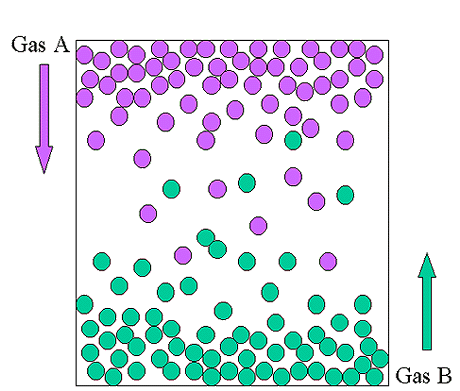
Estimation of Mass Diffusivity at Low Density
Mass Diffusivity (Dab) for binary gas mixtures at low pressure is a function of pressure and temperature, and nearly independent of composition for any gas-pair system. The equation 16.3-1 of Bird, Stewart, and Lightfoot is used to estimate mass diffusivity for gas-pairs at low pressures.
The following picture shows a binary system of gas A and gas B, where both gases are diffusing into each other:

Now, let's work through two examples that will deal with binary gas systems such as the one shown in the picture.
Example 1
This is the example 16.3-1 given in BS&L.
Estimate the mass diffusivity for the gas-pair system argon-oxygen at 293.2K and 1atm total pressure.
> restart;
Equation 16.3-1, the equation used for estimation:
> eq1:= p*Dab/(Pca*Pcb)^(1/3)/(Tca*Tcb)^(5/12)/(1/Ma + 1/Mb)^(1/2) = a*(T/sqrt(Tca*Tcb))^b;
![[Maple Math]](images/402project1.gif)
For this system, we know the following, where gas A is argon and gas B is oxygen:
T = 293.2K (temperature of the system)
Pca = 49.0 atm (critical pressure of argon)
Pcb = 49.7 atm (critical pressure of oxygen)
Tca = 151.2K (critical temperature of argon)
Tcb = 154.4K (critical temperature of oxygen)
Ma = 39.94 g/mol (molecular weight of argon)
Mb = 32.0 g/mol (molecular weight of oxygen)
> p:= 1;T:= 293.2; Pca:= 49.0; Pcb:= 49.7; Tca:=151.2;Tcb:=154.4; Ma:=39.94; Mb:= 32;
![]()
![]()
![]()
![]()
![]()
![]()
![]()
Since this is a system of nonpolar gas-pairs, the constants a and b used in the equation are:
> a:=2.745e-4; b:=1.823;
![]()
Therefore, equation 16.3-1 from above can be solved for Dab to find the numerical answer for mass diffusivity:
> solve(eq1,Dab);
From this, we find that the mass diffusivity is 0.1899803852 cm^2/sec.
Example 2
Estimate the mass diffusivity for the system helium-chlorine at 300K and 1 atm total pressure.
> restart;
Using equation 16.3-1 from BS&L:
> eq1:= p*Dab/(Pca*Pcb)^(1/3)/(Tca*Tcb)^(5/12)/(1/Ma + 1/Mb)^(1/2) = a*(T/sqrt(Tca*Tcb))^b;
![[Maple Math]](images/402project13.gif)
For this system, we know the following information, where gas A is helium and gas B is chlorine:
T = 300K (temperature of the system)
Pca = 2.26atm (critical pressure of helium)
Pcb = 76.1 atm (critical pressure of chlorine)
Tca = 5.26K (critical temperature of helium)
Tcb = 417K (critical temperature of chlorine)
Ma = 4.003 g/mol (molecular weight of helium)
Mb = 70.91g/mol (molecular weight of chlorine)
> p:=1;T:=300;Pca:=2.26;Pcb:=76.1;Tca:=5.26;Tcb:=417;Ma:=4.003;Mb:=70.91;
![]()
![]()
![]()
![]()
![]()
![]()
![]()
Since this is a system of nonpolar gas-pairs, the constants a and b used in the equation are:
> a:=2.745e-4; b:=1.823;
![]()
Here we solve equation 16.3-1 to find Dab:
> solve(eq1,Dab);
From this, we find the estimation of mass diffusivity is 0.5713896655 cm^2/sec for the specified system.